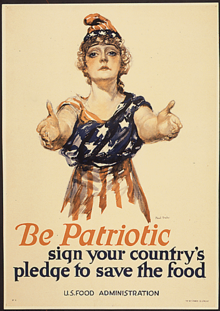This article needs additional citations for verification. (July 2015) |

The United States Food Administration (1917–1920) was an independent federal agency that controlled the production, distribution and conservation of food in the U.S. during the nation's participation in World War I. It was established to prevent monopolies and hoarding, and to maintain government control of foods through voluntary agreements and licensing. The agency was established by Executive Order 2679-A of August 10, 1917, pursuant to the Food and Fuel Control Act, and was abolished by Executive Order 3320 on August 21, 1920. Herbert Hoover was appointed to serve as Food Administrator.[1]
One of the agency's important tasks was the stabilization of the price of wheat on the U.S. market. Concepts such as "meatless Mondays" and "wheatless Wednesdays" were also implemented to help ration food, so that the government could prioritize the war effort.
Branches of the United States Food Administration were set up in all states as well as Alaska, Hawaii, Puerto Rico and Washington, D.C. The agency had broad powers but few mechanisms for enforcement of its policies. It relied largely upon patriotic appeals and voluntary compliance in the formal absence of rationing.[1]
- ^ a b "Records of the United States Food Administration". The National Archives at Fort Worth. Retrieved April 1, 2021.
© MMXXIII Rich X Search. We shall prevail. All rights reserved. Rich X Search
